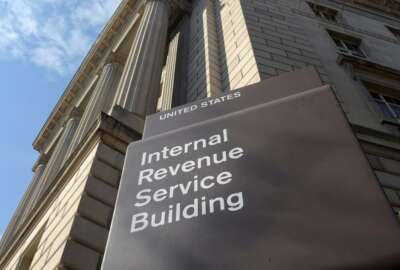
IRS managers, NTEU waiting on answers as agency looks at reopening more services
Organizations that represent IRS managers and employees say they haven’t been given much detail on the agency resuming more of its operations.
By next week’s tax filing season deadline, the IRS expects to return to “full staffing” for its tax processing and call centers, Commissioner Chuck Rettig recently told the Senate Finance Committee.
While watchdog reports show the IRS has seen significant backlogs in much of its work after issuing a mandatory evacuation notice in late March, organizations that represent IRS managers and employees say they haven’t been given much detail on the agency resuming more of its operations.
The Professional Managers Association, in an update posted on its website late last month, said it expected all walk-in offices to resume operations by July 27, while others already reopened in late June.
However, PMA President Chad Hooper said IRS employees will “face unique challenges, which vary widely from location to location,” and depending on their positions.
While the National Treasury Employees Union said the IRS has “not provided a clear outline of how employees will be protected when sitting across from taxpayers,” Hooper said IRS officials had declined PMA’s request for a briefing on reopening procedures.
Hooper said his association is also waiting on guidance from the IRS on enforcement activities once the agency’s “People First Initiative” ends July 15. The initiative put a hold on certain enforcement work.
In a letter to the leadership of the Senate Finance and House Ways and Means Committees, Hooper also told lawmakers that Federal Protective Service employees and contracted security officers in some cases have failed to wear masks as employees enter the building.
“This poses a direct threat to the health and safety of IRS workers,” he wrote. “IRS employees should not be concerned about contracting the coronavirus while entering their offices, they should only be concerned about the mission they are entering those offices to complete.”
Storing backlogged pandemic mail in trailers
Amid these workforce concerns, the Treasury Inspector General for Tax Administration has underscored the severity of backlogs that have accumulated during the pandemic.
TIGTA, in a report released Wednesday, found the IRS has had to close four of its Tax Processing Centers during the pandemic because the work is “performed onsite and is not conducive to telework.”
In closing these centers, the IRS followed its same guidelines for a government shutdown, but auditors said they “had less time to prepare due to the urgency of the health crisis.”
With few employees coming into the office, the IRS has been backlogged with more than 10 million pieces of mail during the pandemic. Auditors said agency officials have stored their backlog of mail in 20 trailers and six storage containers.
The IRS in late April asked about 10,000 employees working at 10 campus locations to return to the office to begin opening mail and process tax returns. The agency for several weeks offered pay incentives for employees that volunteered.
Around that same period, the agency saw 10 million paper tax returns from individuals and 6.6 million paper returns from business fill up its inbox.
The IRS also saw case backlogs grow in other areas of operations: 1.7 million tax returns in its error resolution inventory went unresolved, as did 2.5 million cases in its accounts management inventory and 1.6 million returns flagged for potential fraud.
Nationwide office closures also led the agency to shut down all 358 Taxpayer Assistance Centers and the agency’s toll-free telephone hotlines. TIGTA as of May 20 found nearly half of the IRS’ 105 phone lines still didn’t work.
The lack of phone support affects taxpayers looking for answers to tax-law questions, requests for transcripts and appointments for in-person assistance.
While the IRS expects to reopen all Taxpayer Assistance Centers by the end of this month, TAC employees weren’t eligible for telework during the pandemic and didn’t receive laptops for remote work.
Read more: Workforce News
IRS managers told TIGTA about a pilot program that ran before the pandemic, which allowed TAC employees to provide virtual assistance to taxpayers, but said they “have no intention of expanding this service at this time because they do not have the results of the pilot to know if this was effective.”
Managers told auditors in June that the software used in the pilot doesn’t have the “system capabilities to be used nationwide.”
Employees looking to telework must receive the necessary equipment, complete their training and sign telework agreements with their managers. IRS management told TIGTA that they could get 200-to-400 employees ready to telework each week.
TIGTA found 8,427 employees were not telework-ready in mid-May and remained on weather and safety leave.
While members of Congress expressed outrage over a Government Accountability Office report that found more than a million pandemic payments went to dead people, TIGTA said the IRS sent the correct payment of 98% percent of recipients.
Moreover, payments to the deceased and to incarcerated people amounted to less than 1% of the total number of payments issued.
The IRS has issued more than 160 million payments worth more than $264 billion, with the first wave of payments going out just two weeks after Congress passed the CARES Act.
Copyright © 2025 Federal News Network. All rights reserved. This website is not intended for users located within the European Economic Area.
Jory Heckman is a reporter at Federal News Network covering U.S. Postal Service, IRS, big data and technology issues.
Follow @jheckmanWFED
Related Stories

In sending checks marked ‘deceased,’ IRS prioritized payment speed




